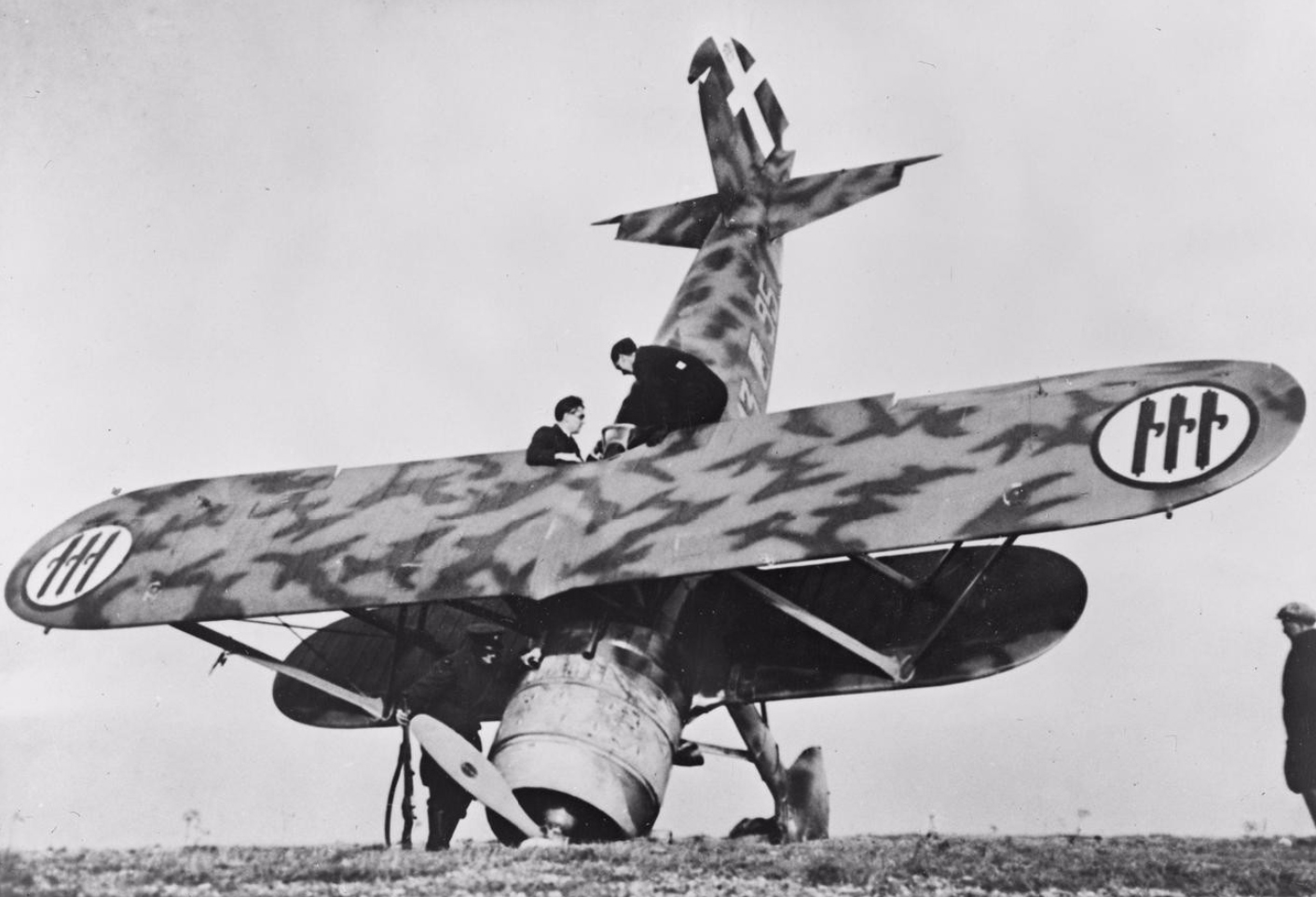Sergeant Pietro Salvadori desperately tried to determine what was causing the engine of his Fiat C.R.42bis biplane fighter to overheat as he neared England’s south coast on November 11, 1940. The Italian airman soon realized he would have to shut it down and make an emergency landing. He glided toward a smooth stretch of beach near the lighthouse at Orfordness, hoping he could fix the engine, take off and return to his unit, the 95th Squadron, in Belgium. His landing was perfect, but after the Fiat’s wheels hit a soft spot in the sand, Salvadori found himself hanging by his seatbelt, with the plane’s nose buried in the sand and its tail pointing skyward. He gingerly eased himself over the hot engine cowling and onto the beach, where the British Home Guard took him prisoner. For Salvadori, World War II was over.
Languishing in a POW camp, he had plenty of time to ponder the march of events that had landed him in prison. On June 10, 1940, Italian dictator Benito Mussolini—believing that Germany had already won—baldly declared war on France and Great Britain. Mussolini expected a quick victory that would increase Fascist Italy’s prestige, help achieve his expansionist goals in North Africa and confirm his own domination of the Mediterranean. Just two days later RAF Bomber Command dispatched 36 Armstrong Whitworth Whitleys on a long-range mission to attack aircraft factories in Genoa and Turin. Because of bad weather, only 13 bombers reached their targets, but the unexpected raid raised considerable concern among the Italians, many of whom were unhappy about entering the war. On June 15, Vickers Wellingtons bombed aircraft factories in Genoa. The attacks on the Italian heartland enraged Mussolini, who was worried about their effect on civilian morale and his image as a leader.
Mussolini soon contacted Adolf Hitler and offered to send an expeditionary air corps to assist in the forthcoming attack on the British Isles. Although Hitler was at first hesitant, he soon saw the political and propaganda benefits of having his Axis ally engaged in the coming battle, and eventually accepted Mussolini’s offer.
Hermann Göring, the Luftwaffe commander in chief, and other members of the German high command were less than enthusiastic: They were certain the Italians’ outdated aircraft and lack of modern combat experience would hinder air operations. Members of the Italian Supreme Command in Rome, realizing they would have their hands full battling the British in both North and East Africa, were equally unenthusiastic. But Il Duce’s order must be obeyed.
Field Marshal Albert Kesselring, commander of Luftflotte 2, was notified in early August to prepare for the arrival of the Corpo Aereo Italiano (CAI). He complied, even though he considered the Italian involvement more of an annoyance than a worthwhile contribution to the campaign. Mussolini directed the commander of the Regia Aeronautica (Royal Air Force) to establish the CAI without delay. It would be equivalent to about three RAF wings, consisting of two bomber wings and one fighter wing. Air Marshal Rino Corso-Fougier, a veteran commander and pilot who nonetheless had little combat experience, would head up the expeditionary force.
Preparations for the deployment took longer than expected, but the Italians sent a small liaison staff, including several German-speaking men, to the headquarters of Luftflotte 2 to begin making arrangements for the CAI’s arrival. The Italian combat units were headed for four air bases in Belgium, and billeting, repair facilities and security for CAI men and planes there were assigned to the German National Labor Service, a semimilitary construction organization. Despite Mussolini’s impatience, the CAI was not officially organized until September 10, with training and equipping of the expeditionary force completed later that month.
Caproni Ca.133 transports brought in personnel, tools, spare parts and equipment to set up shop in Belgium. Since Italian bombs, ammunition and parts were not interchangeable with those of the Germans, they had to be shipped by train from Italy. The Germans provided fuel, tents, rations and other supplies.
Fiat B.R.20M bombers left Italy on September 25 for the flight over the Alps to Frankfurt am Main, and on to bases in Belgium. Bad weather and malfunctioning navigation instruments resulted in two damaged bombers and one destroyed during forced landings in Belgium. But the fighter units made it safely to their Belgian bases, with stops in Munich and Frankfurt. By October 22, the entire CAI was in Belgium and preparing for operations, making familiarization flights around the bases.
The CAI then began the complicated process of coordination with the Luftwaffe’s II Fliegerkorps, made more difficult because of language problems and differing procedures. The Italians also learned that winter weather in northern Europe was more severe than in most parts of Italy, which meant pilots urgently needed training in instrument and night flying.
The Germans were unimpressed with the Italian aircraft and aircrews. The C.R.42bis Falco (Falcon) biplane fighters were hopelessly inadequate for combat against the RAF’s Supermarine Spitfires and Hawker Hurricanes, which were armed with eight .303-inch Browning machine guns and had top speeds of 355 mph and 342 mph, respectively. Introduced in 1939, the C.R.42s were sturdy and extremely maneuverable, but their top speed was only 267 mph, with a range of 481 miles. Armament consisted of two synchronized 12.7mm Breda-SAFAT machine guns mounted above the cowling of the 840-hp Fiat radial engine.
The Fiat G.50 Freccia (Arrow) monoplane fighter first entered service in 1938. It was equipped with the same 840-hp Fiat engine and armament as the C.R.42bis, but had a top speed of 293 mph and range of 621 miles. Amazingly, only three of the CAI Freccias were equipped with radios, and all the Italian fighters lacked adequate instruments for navigation at night and in bad weather.
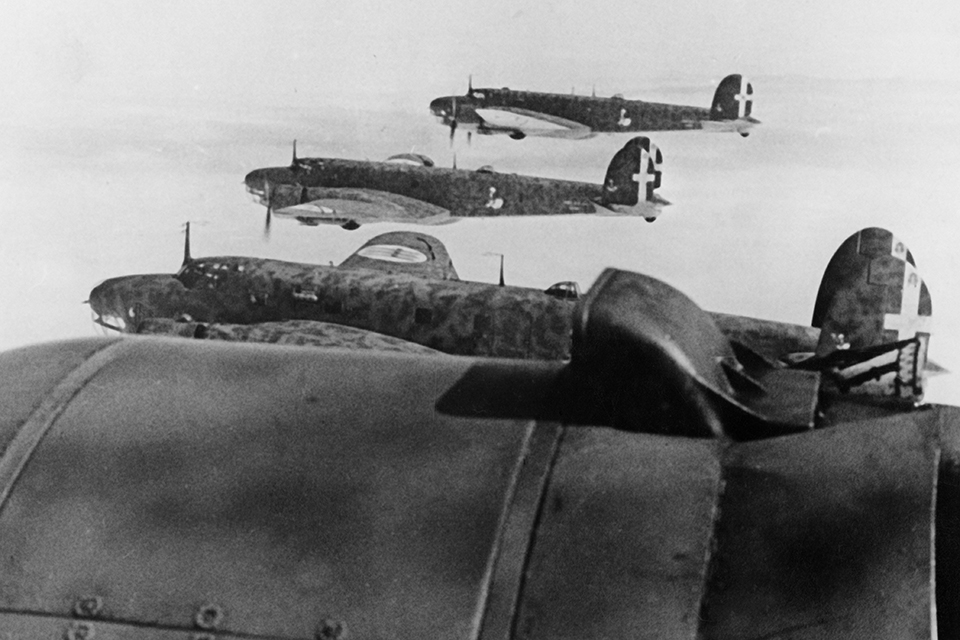
The twin-engine B.R.20 Cicogna (Stork) was one of the most advanced bombers of the mid-1930s, but by 1940 even the improved B.R.20M was becoming outdated. Fitted with 1,000-hp Fiat radials, the B.R.20M flown by the CAI had a top speed of 268 mph and a range of 1,243 miles. The Cicogna’s armament consisted of a flexible 12.7mm Breda-SAFAT machine gun in the nose, two 7.7mms in the dorsal turret and one 7.7mm in the ventral position, with two additional 12.7mm guns aimed manually from lateral blisters. It carried a 5,511-pound bombload. One problem that soon became obvious was the bomber’s lack of deicing equipment.
The Luftwaffe initially assigned CAI units the east coast of England, between the Thames River and Harwich, as their operating area. By late October, operational cooperation, weather reports and other arrangements between the two Axis allies had been worked out fairly well, and CAI headquarters reported its units were ready for action. There was great activity and excitement at the CAI bases on the night of October 24, when combat operations finally began with bombing raids on Felixstowe and Harwich by 12 B.R.20Ms of the 13th Bomber Wing and six from the 43rd Bomber Wing. One plane crashed shortly after takeoff, however, and only 10 B.R.20Ms located Harwich and dropped their bombs. Two Cicognas became lost during the return flight and crashed, and another was damaged during a forced landing.
The initial mission’s results were clearly less than impressive, especially since the Italians had encountered no British defensive action in the course of their night raid. Still, the newspapers back home made good propaganda out of this first Italian air raid on the British Isles.
For weeks the Germans had conducted strong daily raids against British targets, featuring dramatic air battles in the skies over southern England. German Field Marshal Erhard Milch, among the CAI’s detractors, reportedly stated that “Mussolini’s contingent was more of a liability than an asset.” Although night operations were less risky, they were obviously more difficult. After that first raid, German and Italian commanders decided on a change in strategy for the CAI: The Italians would mount a daytime mission.
On the afternoon of October 29, 15 B.R.20Ms from the 43rd Wing took off to bomb Ramsgate Harbor, escorted by 39 C.R.42bis and 34 G.50 fighters, plus a group of Luftwaffe Messerschmitt Me-109Es. Almost immediately engine trouble forced three of the bombers down. The remaining 12 reached the target at low altitude, flying in an unusual formation, wingtip to wingtip. Anti-aircraft gunners watched this approaching formation of unfamiliar aircraft with some confusion, but once they finally opened fire they damaged five bombers. Reports indicate the Italians dropped 75 bombs in haphazard fashion before they quickly departed. One damaged bomber made a forced landing at Chièvres, but the rest returned to base.
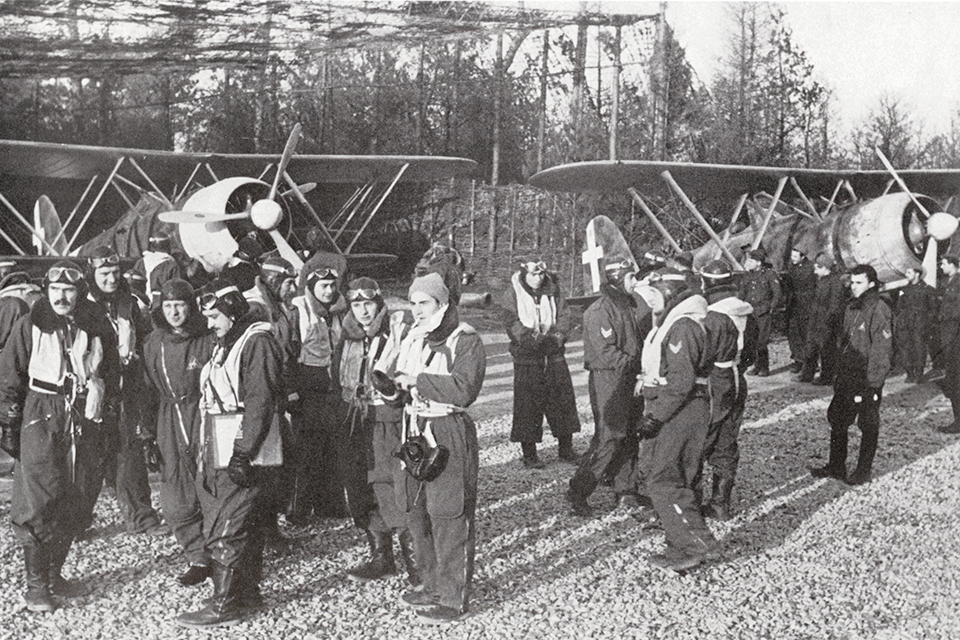
Large formations of G.50 and C.R.42bis fighters made sweeps over several towns in southern England on November 1, but surprisingly encountered no opposition. After further training, the Italians carried out a night raid on Harwich and Ipswich, during which 13 B.R.20Ms of the 13th Wing dropped their bombs and returned to base with only one bomber damaged in the process. Inclement weather delayed operations until November 8, when 22 G.50s of the 20th Fighter Group made a sweep over coastal towns, including Folkestone and Margate, and as far inland as Canterbury. This time four Spitfires intercepted the Italians, and in the short dogfight that ensued, one Spitfire was damaged and had to make a forced landing. Five B.R.20Ms made a low-level raid on targets in the Ramsgate area on the night of November 10-11, returning without losses. Italian fighters also occasionally escorted German Junkers Ju-87B Stukas during attacks on British merchant shipping in the English Channel.
By then the Italian airmen had settled into a routine at the Belgian airfields. They generally enjoyed good relations with the Germans, especially with the labor service workers. But with the onset of winter weather, the aircrews, mechanics and support personnel—who mostly lived and worked in tents, and had to repair their aircraft in the open—were suffering in the frigid conditions. The Italians also complained about the German rations, obtaining fruit and vegetables from Belgian civilians whenever possible.
By early November, the main daylight battles were almost over, and the Luftwaffe was concentrating on night raids against British cities and industry. At a meeting attended by Air Marshal Corso-Fougier and officers of II Fliegerkorps, the decision was made to launch a major CAI raid on November 11. No one brought up the fact that it was the anniversary of the armistice ending World War I—and that Italy had been on the side of the victorious Allies in 1918.
November 11 dawned cloudy and cold, but according to plan 10 B.R.20M bombers took off at noon and attempted to rendezvous with a large group of fighter escorts. Bad weather soon set in, forcing 46 G.50s, as well as a squadron of German Me-109s, to return to their bases. But 42 C.R.42bis fighters managed to form up with the bombers and head out across the Channel and North Sea toward Harwich. At about 1330 hours, British radar picked up the Italians, and 30 Hurricanes of Nos. 17 and 257 squadrons scrambled to intercept. A flight of Hurricanes from No. 46 Squadron, which was already on patrol, was also directed to intercept the intruders. A massacre was in the making.
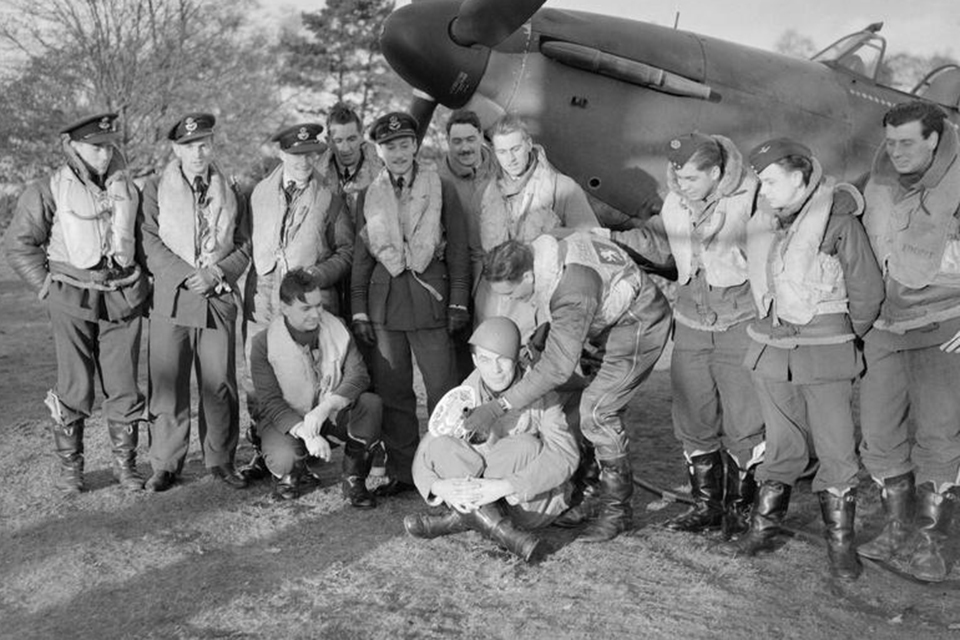
When the leader of No. 257 Squadron spotted a “V” formation of enemy bombers at 12,000 feet, he called out “Tally ho” and initiated a starboard beam attack from above. Almost simultaneously, Hurricanes from 46 Squadron arrived and attacked the bombers from the port side. The No. 257 Squadron pilots roared in close to the formation and, despite defensive fire, quickly shot down four bombers.
Some of the Italians managed to bail out, but one crewman met a horrible end after he apparently pulled his ripcord too soon: His parachute snagged on one of the bomber’s rudders, dragging him down into the North Sea’s cold waters. A 46 Squadron pilot caught yet another B.R.20M heading for the coast. When the Hurricane made a second firing pass, one of the bomber’s engines burst into flames, sending plane and crew down to the sea. Pilots from 46 Squadron bagged one more bomber, which crashed in a forest near Ipswich, then joined a 257 Squadron pilot in an attack on a bomber that dived away with both engines smoking. Only a few bombs, probably 250 kg, were reported to have landed on and near the port at Harwich.
Meanwhile, Spitfires of 41 Squadron had intercepted the C.R.42 fighter escort. A wild dogfight ensued, eventually involving Hurricanes of 257 Squadron as well. The Fiats were no match for the RAF fighters, but the Italians, who were good pilots, tried to use the biplanes’ excellent maneuverability to their advantage. As the aircraft twisted and turned, one 257 Squadron pilot ran out of ammunition—then rammed the upper wing of a C.R.42 with his propeller, causing it to crash near a railway station. At least three Fiats crashed into the sea near Orfordness, and others were damaged during the melee. It was prior to this battle that Sergeant Salvadori had been forced down with engine trouble on the beach at Orfordness.
The RAF after-action report stated that the British sustained no losses in the battle, but at least two fighters had been damaged by fire from the C.R.42s and B.R.20Ms’ gunners. The RAF claimed a total of nine B.R.20Ms destroyed and one damaged, and five C.R.42s destroyed and seven damaged. When engineers at Farnborough examined a B.R.20M that had crash-landed near Woodbridge, they noted that its six crewmen were equipped with steel helmets and 6.5mm M91 Carcano carbines with bayonets.
The Italians, on the other hand, claimed they had destroyed nine RAF fighters. The reader can decide which version of the battle seems more credible.
As the scattered CAI aircraft beat a hasty retreat toward Belgium, four B.R.20Ms made forced landings at Antwerp-Deurne and on the sands at Dunkirk, near the section of beach still littered with wreckage from the British evacuation in May. Three more damaged bombers landed at German airfields. The C.R.42s fared even worse: Nineteen made forced landings at various airfields, either because they were low on fuel or had been damaged. But finding the well-camouflaged German fields was not easy. One hopelessly lost Italian crashed in a city square in Amsterdam. Another plane was destroyed during landing, with two more damaged in the same fashion.
The Italians’ morale was understandably low when they returned from their disastrous mission. Some had suffered frostbite in their open cockpits. The C.R.42bis pilots agreed that it had been a fatal mistake to replace one of the fighter’s 12.7mm machine guns with a 7.7mm to decrease weight and slightly increase range and maneuverability.
Adding to the gloom, the CAI men also learned that several Italian battleships had been sunk or badly damaged in southern Italy’s Taranto Harbor during a daring attack that day by Royal Navy Fairey Swordfish. What’s more, Italian forces were doing badly in battles with the British in Africa. And after Mussolini foolishly attacked Greece on October 28, that offensive bogged down in the face of heavy resistance in the snowy mountains along the Albanian border.
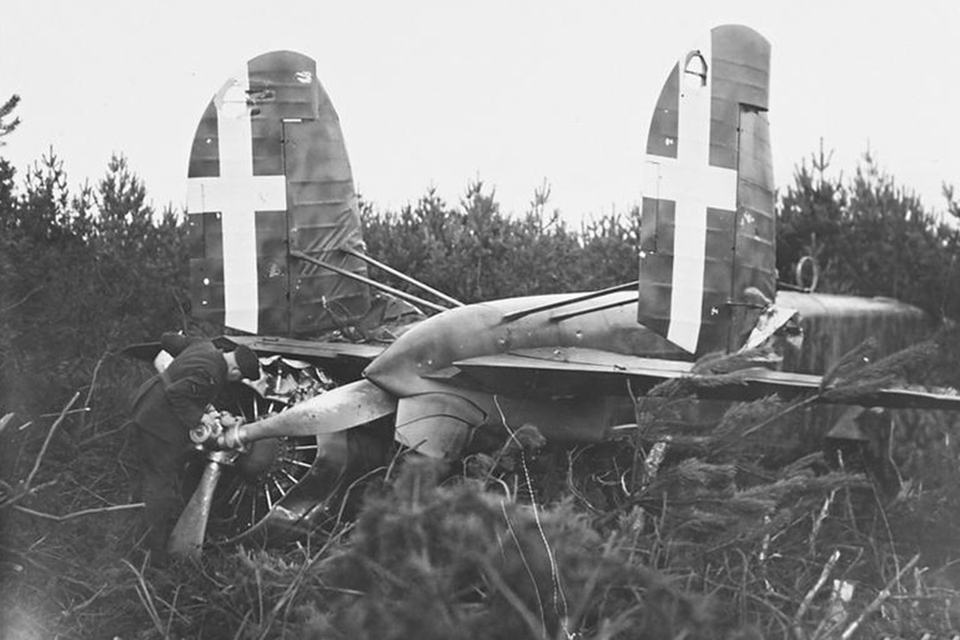
As the weather improved on the afternoon of November 11, the CAI attempted to bomb Great Yarmouth with five Cant Z.1007bis bombers, escorted by 24 G.50s of the 20th Fighter Group. The raid had originally been intended as a feint before the main Italian bomber attack on Harwich. This time, at least, the Italians suffered no losses.
On the night of November 17-18, six B.R.20Ms from the 43rd Wing managed to bomb Harwich and return without losses. That was followed by a raid three nights later in which 12 B.R.20Ms of the 13th Wing bombed the English coast, losing one bomber to a night fighter.
Twenty-nine 18th Group C.R.42s made a sweep over southern England on November 23, accompanied by 24 G.50s of the 20th Group. A powerful force of Spitfires from No. 603 Squadron intercepted them and immediately downed two C.R.42s. In the ensuing dogfight, the Italians claimed five victories, but the British reported only one Spitfire Mk. II damaged and seven Italian fighters destroyed, along with two probables. Naturally, the Italian press did not report the CAI’s poor showing in its air battles with the RAF.
The Italians conducted a few desultory bomber raids and fighter sweeps along the English coast in November and December, but like earlier raids they accomplished little. On the night of December 22-23, six B.R.20Ms of the 43rd Wing made the CAI’s last bombing raid on England, attacking Harwich.
On January 3, 1941, all of the CAI’s surviving bombers and C.R.42bis fighters began taking off for Italy. They would subsequently be deployed to the Balkans and North Africa, where they were urgently needed at that point in the war. Some of the 20th Fighter Group pilots remained in Belgium with their G.50s until April 15, flying patrols along the coast in cooperation with the Luftwaffe.
Thus Mussolini’s vaunted air offensive against the British Isles came to an end. Several airmen would be awarded the Gold Medal for Military Valor. But the efforts of the courageous but poorly equipped and inadequately trained members of the Italian air expeditionary corps accomplished little, other than providing grist for Il Duce’s propaganda machine. As for the hapless Sergeant Salvadori, he survived the war and remained in the Italian air force after returning home. He died in a flying accident while piloting a Republic F-84G in April 1953. His C.R.42 has outlived him: Today it can be seen on display at the RAF Museum in Hendon.
Glen Sweeting is a U.S. Air Force veteran and former curator at the National Air and Space Museum. His books include Combat Flying Clothing, Combat Flying Equipment and Hitler’s Personal Pilot: The Life and Times of Hans Baur. Suggested reading: With Wings Like Eagles, by Michael Korda; The Most Dangerous Enemy, by Stephen Bungay; and The Narrow Margin, by Derek Wood and Derek Dempster.
This feature originally appeared in the May 2009 issue of Aviation History.

